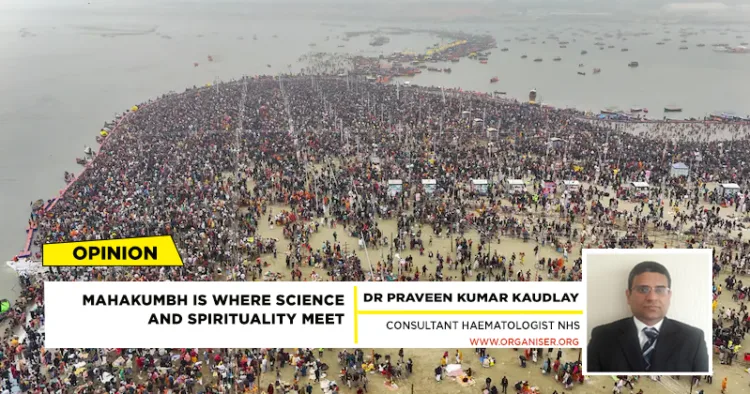The world’s attention is drawn to Prayagraj, where the grand spectacle of the Mahakumbh Mela is underway. This awe-inspiring gathering, steeped in spirituality and tradition, has captivated global curiosity.
The Mahakumbh Mela, a grand spectacle deeply rooted in the Samudra Manthan, the ocean’s celestial churning, holds a significant place in the rich cultural heritage of India. This cosmic event, a battle between the devas (forces of good) and the asuras (forces of evil) to obtain the nectar of immortality, amrita, is the origin of this awe-inspiring gathering.
The mountain Mandara served as the churning rod, while Vasuki, the serpent king, functioned as the rope. The churning produced divine objects and beings, including the sacred pot (Kumbh) filled with amrita. Garuda, the heavenly bird, carried the pot away to prevent a fierce battle over its possession.
The pursuit continued for twelve celestial days, equivalent to twelve human years. During the conflict, drops of amrita spilt onto four earthly locations: Haridwar, Nashik, Prayagraj, and Ujjain. These places, believed to have mystical powers, became sacred sites where devotees gather to bathe in the holy waters to cleanse their sins and reach liberation from the cycle of birth and rebirth.
The Astrological Significance of Kumbh Mela
Astrology plays a pivotal role in the timing and observance of Sanatana Dharma festivals, highlighting their physical, emotional, intellectual, social, and spiritual dimensions. Dr T.P. Sasikumar, a former space scientist associated with the Indian Space Research Organisation (ISRO), underscores the philosophical foundations behind these festivals, emphasising their alignment with planetary positions.
The festivals are intricately timed according to astrological configurations, a fascinating aspect that adds to the allure of the Kumbh Mela. For instance, January 14th marks the observance of Sankranthi across India (except Kerala), symbolising a new beginning. This celebration is linked to the celestial alignment of Jupiter, the Sun, and the Moon. Specifically, the Kumbh Mela occurs when Jupiter transitions into certain zodiac signs while the Sun and Moon occupy complementary positions.
Jupiter’s orbit around the Sun takes approximately 12 years, making this the grand Kumbh Mela celebration interval. Each of the four sacred locations where the event is held corresponds to a unique astrological configuration:
Prayagraj (Allahabad): Nestled at the confluence of the Ganga, Yamuna, and Saraswati rivers, the Kumbh Mela here is celebrated when Jupiter enters Taurus (Vrishabha), and the Sun and Moon align in Capricorn (Makara).
Haridwar: Located on the banks of the Ganga River, this Kumbh Mela occurs when Jupiter transitions into Aquarius (Kumbha), and the Sun and Moon occupy Aries and Sagittarius, respectively.
Nashik: Situated along the Godavari River, the festival here is celebrated when Jupiter is in Leo (Simha), and the Sun and Moon align in Cancer.
Ujjain: Held on the banks of the Shipra River, the Kumbh Mela in Ujjain occurs when Jupiter is in Leo, with the Sun and Moon positioned in Aries.
This intricate astrological connection underscores the profound harmony between celestial movements and spiritual practices in Indian tradition, lending this grand spiritual congregation a cosmic rhythm.
The Transference of Energy at the Kumbh Mela
Dr TP Sasikumar sheds light on the unique energy dynamics at the confluence of the Ganga, Yamuna, and Saraswati rivers, which originate in the Himalayas. These rivers carry a wealth of minerals, herbs, and medicinal properties, enriched by their mountain journey. The energised water, flowing naturally from higher to lower potential, works under the fundamental laws of physics, creating a powerful and vibrant atmosphere at the Kumbh Mela.
The groundbreaking experiments of Japanese researcher Dr Masaru Emoto further illustrate the transformative properties of water. His studies proved that water could record environmental vibrations, keeping them as “memory” observable in frozen water crystals under a microscope.
When millions of devotees gather at the Kumbh Mela to engage in rituals, meditation, and prayers, the water absorbs the energy created by their collective actions. Dr. Sasikumar notes that this phenomenon is amplified by ascetics such as Naga Sadhus, Aghoris, Yatis, and Puri-order sadhus, whose spiritual practices contribute to the environment’s heightened vibrational state.
“The congregation represents a collective consciousness, poised for a shared spiritual awakening among those who partake in the event,” sees Dr. Sasikumar. This interplay of natural and spiritual energies creates a unique atmosphere profoundly resonating with the essence of the Kumbh Mela.
The Mystical World of the Kumbh Mela
Maria Wirth, a German national residing in India since the 1980s, has long shared her profound connection to the spiritual depth of the country through her books and articles. Shortly after she arrived in Bharat, she attended a Kumbh Mela—a transformative experience that left an indelible mark on her life. In the presence of revered sages such as Sri Anandamayi Ma and Devaraha Baba, she gained a deeper understanding of the essence of Sanatana Dharma.
One remarkable encounter is among her cherished memories of the four Kumbh Melas she has attended. During a grand procession of Naga sadhus heading for their ritual Snan on Shivaratri, Maria stood by the roadside, captivated by the spectacle. To her surprise, one of the sadhus paused before her and asked for 100 rupees. Though she did not have a 100-rupee note, she offered him 50 and 20-rupee notes instead. The sadhu saw, “30 rupees are missing.”
Amused, she asked if he could exchange it for a 200-rupee note. To her astonishment, he agreed, carefully folding the notes into a small bundle and pressing them into her palm. “Close your hand and keep it closed,” he instructed. Moments later, she felt a change in her hand. Upon opening it, she discovered a small Shiva Linga—a moment of sheer wonder that amazed her and those around her.
To this day, Maria treasures the Shiva Linga as a tangible symbol of the mystical power she met during that sacred gathering. Her experience underscores the extraordinary encounters and spiritual awakenings that make the Kumbh Mela a transcendent experience for seekers worldwide.
Dr Sasikumar sees that it is still a mystery how the Naga Sadhus, living in some of the most remote and challenging terrains under harsh climatic conditions, make their way to every Kumbh Mela without formal invitations.
The Purity of the Holy Waters
A 2019 case study conducted by the Central Pollution Control Board (CPCB) analysed the water quality of the Ganga and Yamuna rivers before and after the Kumbh Mela. Despite the participation of millions of devotees who took ritualistic dips in the rivers, the study revealed that the water quality during and after the event remained within permissible limits. The dissolved oxygen (DO) levels—a key indicator of water health—were consistently kept within the allowable range for bathing.
The Kumbh Mela is a remarkable unifier for millions worldwide, transcending background, caste, and religion barriers. The Ganga Yamuna and Saraswati holy waters symbolise inclusion, purity, and acceptance, embracing all who come to partake in this sacred gathering.












![A Representative image [ANI Photo]](https://organiser.org/wp-content/uploads/2025/12/representative-image-e1765612818961-120x70.webp)







Comments